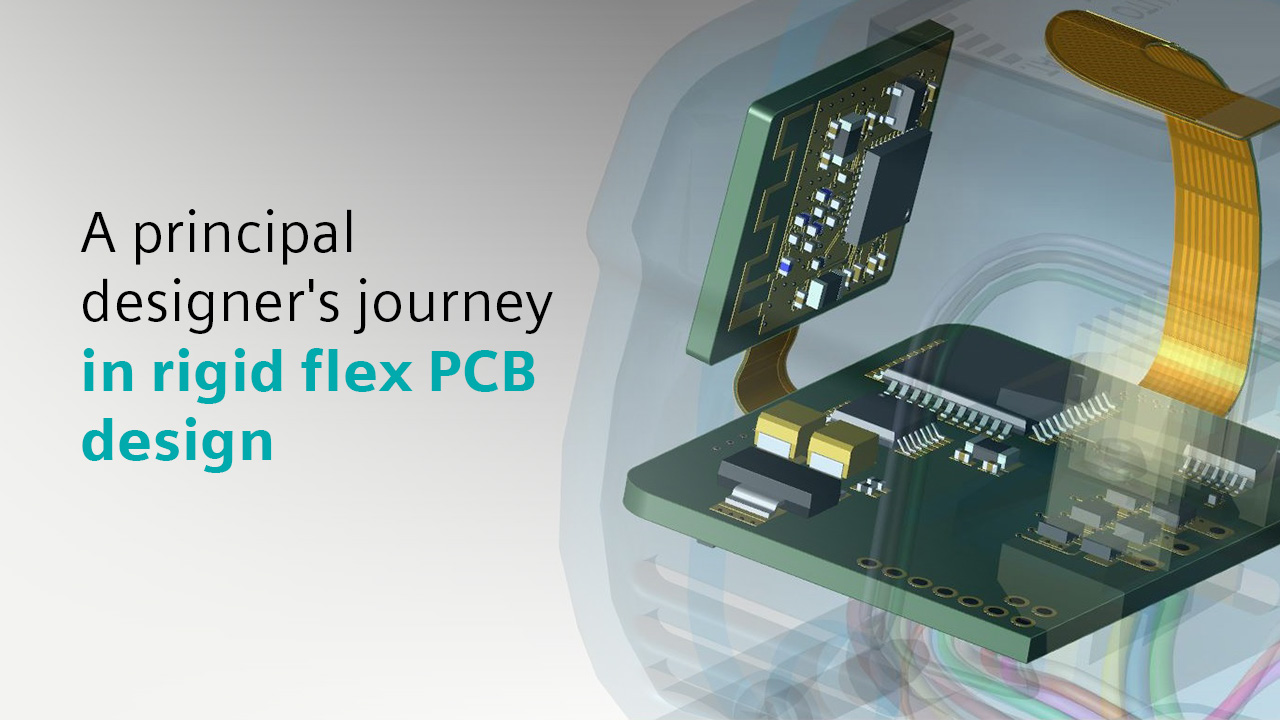A principal designer’s journey in rigid flex PCB design

As technology continues to advance, the demand for smaller, lighter, and more efficient electronic devices is ever-increasing. This demand has led to the emergence of rigid flex PCBs, a revolutionary technology that combines the benefits of rigid and flexible circuits into a single solution.
What is rigid flex PCB design?
As a principal PCB designer with several decades of experience in designing a wide spectrum of PCB technologies, I’ve had the privilege of delving deep into the world of rigid flex PCB design. In this blog post, I’ll share some insights and experiences from my journey within this fascinating technology.
Advantages of rigid flex PCBs
As I have progressed in my evolution as a PCB designer, more specifically with regards to rigid-flex PCB design, this technology has always presented a unique set of challenges and opportunities compared to traditional rigid PCBs or flexible PCBs. One of the most significant advantages of rigid-flex technology is its ability to reduce space and weight in electronic devices while improving reliability and durability. However, achieving these benefits requires a thorough understanding of both rigid and flexible circuit design principles, as well as the nuances of integrating them seamlessly.
Demystifying rigid flex PCB design
In my early years at my first attempt with a rigid-flex PCB design, the thought alone intimidated me. Back then, rigid flex PCB was kind of like a mystical type thing that was not widely known. Even with several years of rigid PCB designs under my belt, I hesitated due to lack of knowledge in this realm but knew enough to get my fabricator involved at the earliest stages of design. Finding educational content on rigid flex PCB design way back then was not so available. Not like it is today! Plus, today’s EDA tools have come a long way and have far superior capabilities and functionalities to address all the required details and constraints that make up a rigid flex PCB design.
Ensuring mechanical reliability
Aside from collaborating with your PCB fabricator from the very beginning of the project, one of the key considerations in rigid flex PCB design is ensuring proper mechanical reliability. Unlike rigid boards, flexible circuits are susceptible to bending and twisting, which can lead to mechanical stress and fatigue over time. As a result, careful attention must be paid to factors such as material selection, bend radius, and reinforcement techniques to ensure the reliability and longevity of the final product.
Managing signal integrity
Another challenge I have experienced in rigid flex PCB design is managing signal integrity and impedance control. The flexible portions of the board introduce additional impedance variations and signal losses compared to rigid sections, which can affect the performance of high-speed and high-frequency circuits. To address this, designers must carefully analyze signal paths, use appropriate routing techniques, and employ impedance matching strategies to maintain signal integrity across the entire board.
Design for manufacturability
In addition to mechanical and electrical considerations, rigid flex PCB design also requires careful attention to manufacturability and assembly. Design for manufacturability is key. The unique construction of rigid-flex boards introduces complexities in terms of fabrication and assembly processes, which can impact yield, cost, and time-to-market. Working closely with manufacturers and assembly partners is essential to ensure that the design meets all requirements, performs as intended, and can be efficiently produced and assembled with the highest yield and at the lowest cost.
The rewards of rigid-flex PCB design
Despite the challenges, working on rigid-flex PCB designs can be incredibly rewarding. The ability to create compact, lightweight, and highly reliable electronic products opens up a world of possibilities for innovation and advancement. Whether it’s designing wearable devices, medical implants, or aerospace systems, rigid-flex technology offers unparalleled flexibility and versatility for a wide range of applications.
Over the years, I’ve had the privilege of working on numerous rigid-flex PCB projects, each presenting its own set of unique challenges and opportunities. From designing intricate, multi-layered circuits to optimizing layouts for maximum reliability and performance, every project has been a learning experience that has helped me grow and evolve as a designer.
Rigid-flex PCB design represents the future of electronic engineering, offering a compelling combination of performance, reliability, and flexibility. Today, as a printed circuit engineer, I feel fortunate to be part of this exciting journey, pushing the boundaries of what’s possible and helping to shape the future of technology. With continued innovation and collaboration, the potential of rigid-flex technology is limitless, and I look forward to seeing where it takes us next.
To learn more about rigid flex PCB design check out these resources:
- Podcast: PCB Design and the future of advanced manufacturing technologies | Episode 14
- Blog: PCB design best practices: Designing for advanced manufacturing technologies like rigid-flex PCB design and High-Density Interconnect
- Blog: Meeting rigid-flex pcb design challenges with Xpedition
- Webinar: Rigid-flex PCB design guidelines: practical tips and best practices
- Paper: How to overcome flex and flex-rigid design challenges
- eBook: Advanced rigid-flex circuits in today’s PCB designs with PADS Professional


